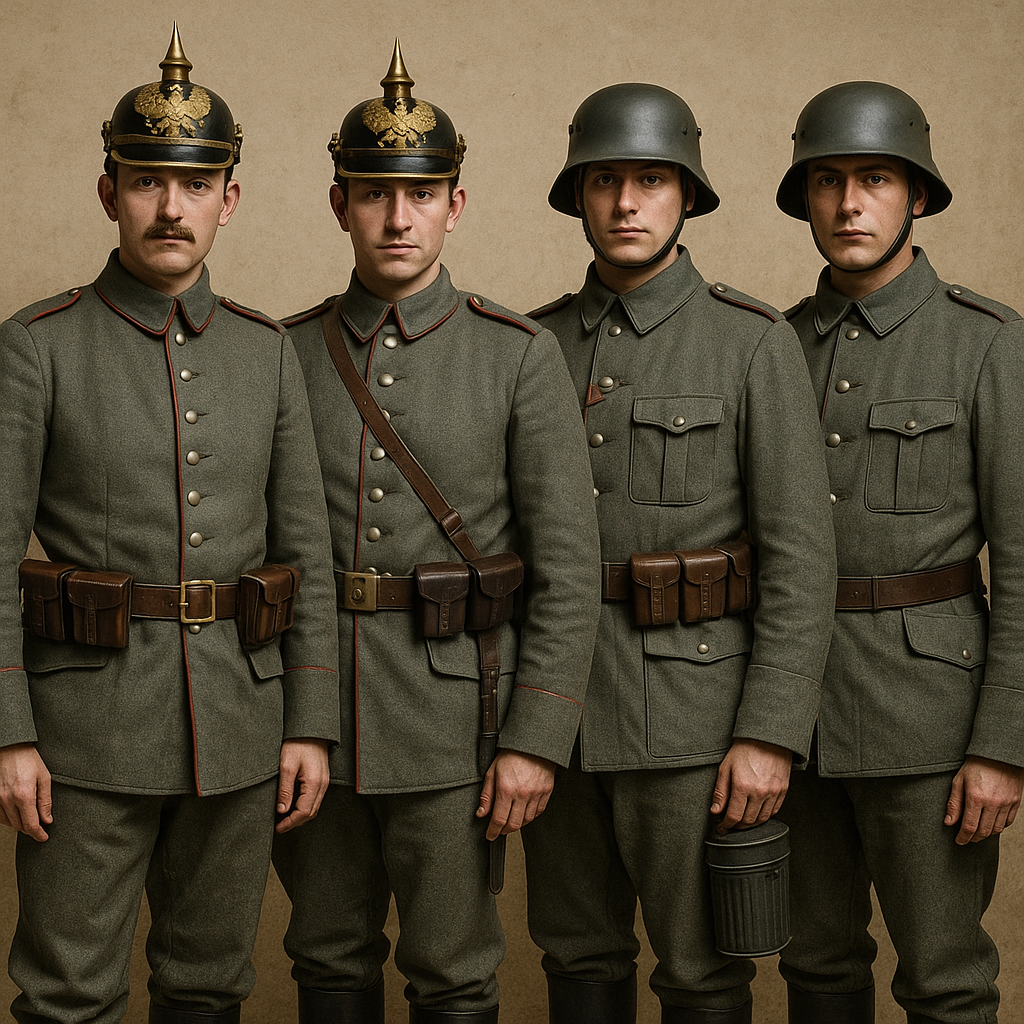
German WWI Uniforms: History, Types & Authentic Replicas | Paddelaters
Published on Jul 01, 2025
German WWI Uniforms: A Guide to History & Authentic Replicas
When you think of World War I, certain images immediately come to mind — trench warfare, barbed wire, and the iconic silhouettes of soldiers in field-gray tunics topped with spiked helmets. The German WWI uniform is not just a piece of military clothing; it’s a symbol of one of the most pivotal periods in modern history.
This article explore the full story behind German WWI uniforms, including their evolution, distinct features, ranks, and why they still fascinate military historians and collectors today.
The Evolution of German WWI Uniforms
Germany entered the Great War in 1914 with a uniform style that reflected the 19th-century mindset—military regalia meant to impress rather than provide camouflage. However, the harsh realities of modern warfare quickly transformed the look and function of a soldier’s attire.
Pre-War Style: The Prussian Legacy
At the start of the war, many German soldiers still wore uniforms influenced by the Prussian tradition. The most recognizable element was the Pickelhaube—a shiny leather spiked helmet. While impressive in parades, it proved inadequate in the trenches and was gradually replaced.
The Shift to Feldgrau (Field Gray)
By 1915, practicality trumped pomp. The introduction of the M1915 field-gray (Feldgrau) wool tunic marked a major transition. This drab color helped soldiers blend into their surroundings and provided warmth in brutal conditions. The tunic came with sewn-in shoulder boards and colored piping to indicate regiment or branch.
Key Components of the German WWI Uniform
Let’s break down the major elements that made up the standard German uniform during the First World War:
1. Pickelhaube Helmet
- Made of boiled leather or metal with a brass spike on top.
- Worn mainly by infantry and guard regiments early in the war.
- Eventually replaced by the Stahlhelm (steel helmet) in 1916 due to better protection against shrapnel.
2. M1910 & M1915 Tunics
- M1910: Earlier model with colored piping and removable shoulder boards.
- M1915: Simplified, mass-produced version with dull buttons and subdued tones.
- Both models featured six-button fronts, stand-and-fall collars, and rear belt hooks.
3. Trousers and Puttees
- Wool trousers in matching Feldgrau.
- Lower legs are wrapped with puttees (cloth strips) to provide support and prevent debris from entering boots.
4. Boots
- Early war: Knee-length leather jackboots (Marschstiefel).
- Later war: Shorter ankle boots due to leather shortages.
5. Field Gear
- Leather belt with brass buckle (Gott mit uns inscription).
- Bread bag, mess kit, canteen, bayonet frog, and gas mask canister.
- Backpacks made of cowhide, often with personal items rolled in a blanket or greatcoat.
Rank and Regiment Insignia
Uniforms also included subtle indicators of rank and unit:
- Shoulder Boards: Color-coded and often included regiment numbers.
- Collar Litzen: Worn by enlisted men to show branches (infantry, artillery, etc.).
- NCO Braiding: Silver tresse on collars and cuffs.
- Officer Tunics: Higher-quality wool, tailored fit, and different insignia.
These details helped command and coordinate the battlefield while maintaining a strict military structure.
Specialized Uniforms by Branch
While the standard field uniform was widely used, each military branch had unique features:
Infantry
- Most commonly wore the M1915 Feldbluse.
- Equipped with Mauser rifles and bayonets.
Artillery
- Red piping on tunics and red collar patches.
- Specialized gear for handling shells and managing horses.
Stormtroopers (Sturmtruppen)
- Late-war elite assault troops.
- Wore lighter gear, camouflaged tunics, and skull insignias.
Aviation and Naval Units
- Aviators wore leather jackets and goggles.
- The Navy had its blue double-breasted tunics and white service caps.
The Stahlhelm: A Helmet That Changed Warfare
The iconic Stahlhelm, introduced in 1916, quickly became one of the most recognized symbols of the German military. Unlike the Pickelhaube, it offered genuine protection from artillery shrapnel.
- The M1916 version was heavy and had side lugs for ventilation.
- Later models included liners for comfort and better chin straps.
The design was so effective that it influenced helmet styles through World War II and beyond.
Collecting and Reenacting: German WWI Uniform Replicas
If you're a collector or reenactor, owning a historically accurate WWI German Authentic uniform is a way to connect with the past. At Paddelaters.com, we specialize in high-quality reproductions that honor the craftsmanship of the originals.
Why Choose Paddelaters?
- Faithful details: Buttons, insignias, stitching—all historically correct.
- Multiple uniform models: M1907/10, M1915 tunics, trousers, and more.
- Accessories included Pickelhaube replicas, belt gear, boots, and gas mask canisters.
- Trusted by reenactment groups and museums across the globe.
Tips for Buying Authentic German WWI Uniform Reproductions
When purchasing or collecting WWI German uniforms, keep the following in mind:
- Do your research: Know the difference between M1910 and M1915 patterns.
- Buy from trusted sellers: Paddelaters offers guaranteed quality and authenticity.
- Check for accurate insignia: Regiment and rank details are key for historical correctness.
- Match gear with uniform: A uniform isn't complete without the right field gear and boots.
Conclusion
The German WWI uniform tells a transition story—from ornate tradition to battlefield function. Every stitch, button, and insignia carries meaning from one of the most intense conflicts in modern history. Whether you’re a collector, historian, reenactor, or enthusiast, owning a piece of that history—through a reproduction or original—connects you directly with the past.
